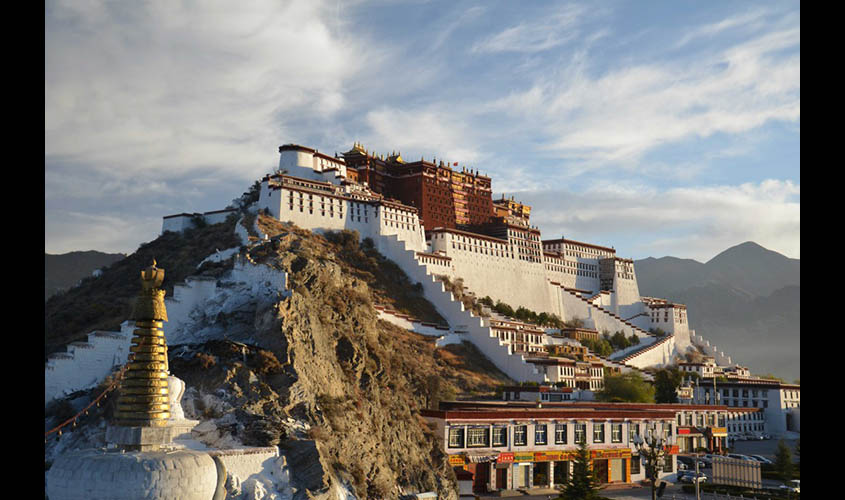High level cadres of the Chinese Communist Party (CCP) do not often travel outside Beijing unless it is to “Red Revolutionary” historical sites or because of a natural calamity or an important event or meeting. The visits to Tibet, therefore, in the short span of a month by the second and fourth ranking members of the CCP’s Politburo Standing Committee (PBSC)—two among the seven who “rule” the People’s Republic of China)—are unusual and significant. At the least it suggests that the top echelon of the CCP is according new, enhanced priority to the Tibet Autonomous Region (TAR).
The visits by Chinese Premier Li Keqiang to TAR this July and Wang Yang, PBSC member and Chairman of the Chinese People’s Political Consultative Conference (CPPCC), which oversees China’s minority nationalities affairs and religious activities, a month later in August 2018 are laced with implications. They signal efforts to accelerate build-up of military infrastructure in Tibet, promote development of “well-off border defence villages”, and intensify efforts to impose religious controls while trying to win over the Tibetan Buddhist clergy to neutralise the Dalai Lama’s influence and calm the Tibetan populace. A conference of Chinese diplomats, convened in Lhasa on 21 August to highlight the achievements in Tibet and addressed by high-ranking TAR cadres and China’s Vice Minister of Foreign Affairs, Zhang Hanhui, points to the possibility of preparations for a major propaganda push—or development—on the Tibet issue.
During his visit to TAR from 25-27 July 2018, Chinese Premier Li Keqiang arrived in Lhasa and travelled to Nyingchi and Lhoka (Shannan). He was accompanied in Tibet by TAR Party Secretary Wu Yingjie and Chairman of the TAR People’s Government Choedak (Qi Zala). Pointedly, Li Keqiang travelled to two of the three locations where it was announced on 8 June 2018, after the stand-off at Doklam, that new airports would be constructed in 2019. The airport at Lhasa was recently extended. The airport near Yume village in Lhoka will be additional to that already existing in Nyingchi. Yume village is also being developed under the poverty alleviation programme as one of a string of “well-off border defence villages” along the borders with India and Bhutan—a programme initiated by Chinese President Xi Jinping at the 19th Party Congress in October 2017. Li Keqiang inspected the construction site of the Sichuan-Lhasa Railway at Nyingchi. Instructions had been issued in the latter half of last year for accelerated completion of this “important” dual-use railway. Li Keqiang’s visit focused on infrastructure development and the economy, but he also spent considerable time on ethnic minority issues and emphasising ethnic unity between Tibetans and the country’s Han majority.
CPPCC Chairman Wang Yang during his visit (24-26 August 2018) to TAR focused on ethnic minorities, religious issues and “opposing splittism”. Acknowledging “Xi Jinping’s Socialism with Chinese Characteristics in the New Era”, he exhorted TAR officials to conscientiously implement the General Secretary and the Party’s strategy of managing Tibet and Tibet affairs, “closely focus on safeguarding the ‘Motherland’s reunification’”, “oppose splittism and separatism” and strengthen national unity. He emphasised the importance of alleviating poverty and building a well-off society, “deepening anti-separatist movements” and creating innovative but effective temple management systems and fostering long-term stability. While visiting Sera monastery, he impressed on monastery cadres the importance of religion and religious activities for maintaining social and long-term stability in Tibet. He asked monks to be prepared for “menace” and “rain”, uphold and follow the “guiding principles” of the Party’s religious works and adapt Tibetan Buddhism to socialist society. It is pertinent that Wang Yang did not once directly criticise the Dalai Lama by name or refer to the “Dalai clique”. Wang Yang was accompanied by TAR Party Secretary Wu Yingjie, Chairman of TAR People’s Government Choedak (Qi Zala), Executive Vice Minister of the United Front Work Department (UFWD) Zhang Yijiong and the Vice President of the Chinese Buddhist Association, Drukhang Khedrup Rinpoche.
Reinforcing Wang Yang’s message, the China-appointed Panchen Lama, Gyaltsen Norbu had an unusually long sojourn (19-31 July 2018) in Tibet. He expressed support for Party policy and its religious policies, visited the Jokhang and Tashilhunpo monasteries and held a “kalachakra” ceremony. His extended stay suggests a growing acceptance by the Tibetan people.
It would signal to Tibetans that the CCP acknowledges Tibetan Buddhist religious leaders and keeps a line of communication open to them. Implicit is that the UFWD would have similar lines of communication open to Tibetan Buddhist religious leaders in exile.
These developments bring into focus the fresh emphasis being given by China’s leadership to calm Tibet, emphasise ethnic unity and “social stability” and eliminate the Dalai Lama’s influence. They highlight the push for completing major infrastructure projects like new airports, “well-off border defence villages” and the strategic Sichuan-Tibet Railway.
Jayadeva Ranade is a former Additional Secretary in the Cabinet Secretariat, Government of India and is presently President of the Centre for China Analysis and Strategy.

